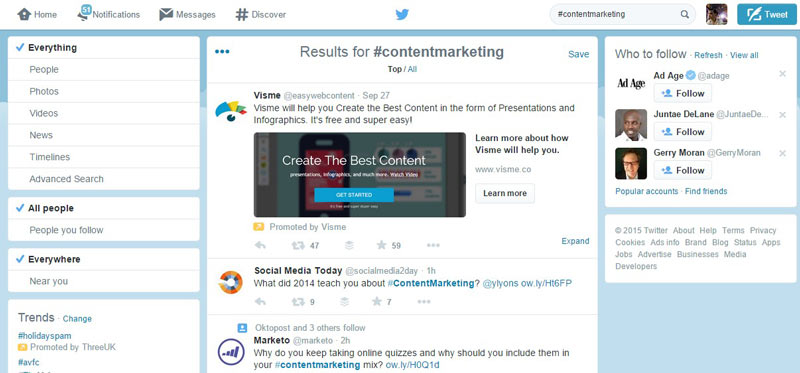
A Comprehensive, Small Business Guide To Twitter
For small businesses Twitter is an invaluable marketing tool. One of the top social media platforms with a growing user base of over 250 million, effective Twitter marketing is now just as important to marketing strategies as traditional TV ads and web banners. With the right strategy, Twitter has the potential to help people find your company, advertise your offerings, establish credibility, create relationships, improve customer relations and ultimately help your business prosper.
Fortunately, harnessing the full power of twitter marketing isn’t hard with the right know-how. Twitter marketing can be broken down into two basic components: gaining followers, and tweeting interesting content to them. Here a look at how your small business can do both.
Choose The Right Voice

Do you want to send out playful tweets casually promoting your goods or services? Or do you need serious tweets for corporate clients? Are your customers (or the people you to become customers) primarily young or old? Are they Local? Do they shop in-store or online? Analyzing your customer base and understanding the best suited voice is essential for efficient Twitter marketing.
Remember that a company’s voice is always the same, but sometimes you may need to use a different tone in your tweets. A company with a playful voice needs to be more serious when dealing with customer complaints or negative news.
Be Yourself
Is it wrong to eat a Blueberry Muffin that looks just like your dog? pic.twitter.com/QgJnsKvjOF
— Renzo Soprano (@Renzo_Soprano) July 26, 2014
While your twitter voice should fit your customer base, it should also be consistent with your company’s character. Twitter users expect authentic personalities, so be honest, be yourself, and let the unique character of your business shine through. Your marketing will be all the better.
Be Transparent And Reputable
Trustworthiness has a value that no marketing budget can buy. If you cant answer a question, say so. If something goes awry, acknowledge it. If a product has a shortcoming, admit it. Always set realistic expectations of what your business can and can’t deliver, and don’t hesitate to suggest other businesses when your company cant fulfill a customers needs.
And theres no shame in acknowledging that your company isn’t perfect and accepting your followers feedback to help make improvements. People will appreciate your honesty and remember your business in the future, even if you can’t meet their needs in the present. Over time, you’ll build your company’s credibility, one conversation (and tweet) at a time.
LeadPages had a few problems recently and I sent them a message asking what was up. I got a prompt reply telling me they were aware of the problems and would keep me updated when it get’s fixed. I appreciated their honesty and it didn’t change my view on them as an excellent landing page provider.
@AdeelMSami @IMHBlog Thanks for your patience! Everything should be working perfectly. Please let us know if you need further assistance.
— LeadPages® (@LeadPages) January 14, 2015
Keep It Conversational
On twitter there’s no need to be formal. Keep your tweets light and conversational with a friendly attitude. Avoid typical marketing speak and run-of-the-mill sales pitches. You only have 140 characters to work with , so you’ll also need to keep tweet concise and straightforward.
Write Interesting Tweets
Engage your audience with humour and wit. Try making unique references to recent trends or clever ways of connecting your product with non controversial news events. By creating entertaining and original tweets, you engage people and spark interest more than you would with a mundane marketing blurb. Plus, if a tweets elicits a laugh, its much more likely to get re-tweeted and shared.
Post Valuable Content
Just looking at the data from analysing 500 popular blogs opt-in forms. 95% didn't use bullet point. Shorter the message the better perhaps?
— Paul @ IMH Blog (@IMHBlog) January 14, 2015
Twitter users clamor for information, so share articles, news stories, interesting facts, inspirational stories, tutorials, tips, and anything else noteworthy that relates to your industry, services or product.
For example say you own a donut shop. Some choice twitter material could include news about the new record for the largest donut, an article about the pastry’s origins, facts about how many of them are eaten every year, and tips for storing donuts in the freezer. Tweeting this kind of interesting, shareable content is essential for gaining followers and exposure for your company.
Tweet Photos and Video
We take you #BehindTheScenes at our #January #ELLEBeauty shoot: get all the juicy details here http://t.co/LKBWRLTTeI
— ELLE Magazine (@ELLEmagazineSA) January 9, 2015
Popular tweets usually contain more than just words. Try tweeting fun photos of employees, company events, or new products with interesting captions. Twitter works great with youtube and vimeo, so its also a great idea to send tweets with embedded videos. And don’t forget to re-tweet relevant tweets your follower might appreciate.
Use The Right Keywords And Hashtag

Think about the keywords that best describe your industry and use them frequently in your tweets. This helps people searching for your industry find your company. Also wisely consider hashtags. These trend focused tags categorize tweets and lets users quickly see all tweets about a given topic.
Hashtags are the driving force of twitter, so use them often. Easily create your own by putting the hashtag symbol in front of of a keyword like this, or use the search tool to find existing, popular hashtags relevant to your tweets. Many social media campaigns use hashtags, so look for ones your company can use in tweets to maximize viewership.
Send Right Mixture of Tweets
For maximum marketing success, your company’s twitter feed should have a lively mixture of informational, playful and promotional tweets with a variety of links, photos, videos, and re-tweets.
Twitter users want to be engaged with meaningful content, not bombarded with endless marketing messages, so don’t send out too many promotional tweets. As a general rule, its good to post one marketing tweet for every fifteen non marketing tweets.
Those 15 can consist of re-tweets, information tweets, links, direct conversations with followers, and anything else that doesn’t mention your product.
Connect With People
Hey @Coke! We included #ShareACoke in our list of 8 brilliant #SocialMedia campaigns! http://t.co/1LGGbfAwea pic.twitter.com/elBjExvF04
— Oktopost (@Oktopost) January 16, 2015
Once you’re in the groove of creating top notch tweets, its time to make connections. Small businesses just getting started on twitter should follow existing customers plus other business and organizations in the community (when you follow people, they’ll generally return the favour). There is nothing wrong with asking personal connections (and employees) to follow and re-tweet your businesses tweets.
Next, use a tool like Follower Wonk, Insightpool to find people in your area interested in your industry and follow them. Focusing especially on people who have a large number of followers. A few people with large followings re-tweeting your tweets can do wonders for twitter exposure and company awareness. Be sure to ban or delete all spammers who follow your business.
Tweet Regularly
Its important to be consistent on twitter, so schedule time for it just like you do email and phone calls. Send out promotional tweets and content tweets at least several times a week. Everyday take some time to answer questions and reply to tweets mentioning your company. Once you gain a large following it may not be possible to respond to everything your followers post, but try to reply as much as possible.
If you want to streamline your scheduling on twitter think about using a service such as Buffer or Oktopost (which we reviewed here).
Engage Your Followers
Don’t just talk at people, talk with them, a big part of successful twitter marketing is engaging people to create relationships and comradery. Be someone your followers can talk with, without an agenda to sell. Follow peoples conversations, give insight, share stories, and add your two cents. Answer as many questions as possible and respond to comments about your company.
Search your business’s name and keyword to find any post mentioning your business. Invite people to share photos of them using your products or answer an offbeat questions. Also, twitter is a great place to gauge customer interest in new products and get input on how to improve your operation.
Use Twitter Tools
You can do a lot with just a twitter account and some time, but after a while you may want to step up your twitter marketing with some of the many available twitter tools. Hootsuite and Tweetdeck are two excellent social media dashboards that let you manage multiple twitter accounts, schedule tweets, analyse account activity, and see what people are saying about your company and your industry as a whole, all inside one interface.
Meanwhile, Topsy is a great service for finding recent, meaningful social media content that’s relevant to your company’s industry and ripe for tweeting.
Another valuable tool that I use is SocialBro. It’s free account has a great feature which lets you see when the highest percentage of your followers are online and will tell you when it’s the best time to tweet.
Consider Promoted Posts
Twitter sells the ability to target tweets and ads to certain users based on a wide range of criteria. Promoted tweets appear in the home timeline of select users, who you can target depending on their interests in certain topics, gender, who they follow, or geographical location (handy for finding local customers). Promoted accounts offer similar benefit, with the added advantage of listing your company in the “who to follow” section of targeted users accounts.
Rick Ramos showed a great case study where he was able to gain hundreds of followers for as little as $0.01 per follower by using twitter ads.
Turn Followers Into Customers
By nature, twitter followers are likely to become customers. By tweeting interesting content and having direct conversations with followers, small businesses build relationships and establish positive reputations even before it’s time to make a sale. Plus, most of your followers choose to follow you because they’re initially interested in your companies field of business and what you offer. Statistics show that twitter users are significantly more likely to buy from companies they follow and more likely to recommend those businesses to friends and family.
Twitter is not only a powerful tool for recruiting customers, it also gives small businesses a way to engage customers and create relationships like no other form of marketing can. But, successful twitter marketing doesn’t happen overnight. Be patient, keep tweeting, and work on developing relationships. Followers will come with time, and after a while, your small business will see the results. Whether its increased sales, better customer relations, or improved brand visibility, your business can reap the benefits when you harness the marketing power of twitter.
Would you like to share your thoughts?
Your email address will not be published. Required fields are marked *